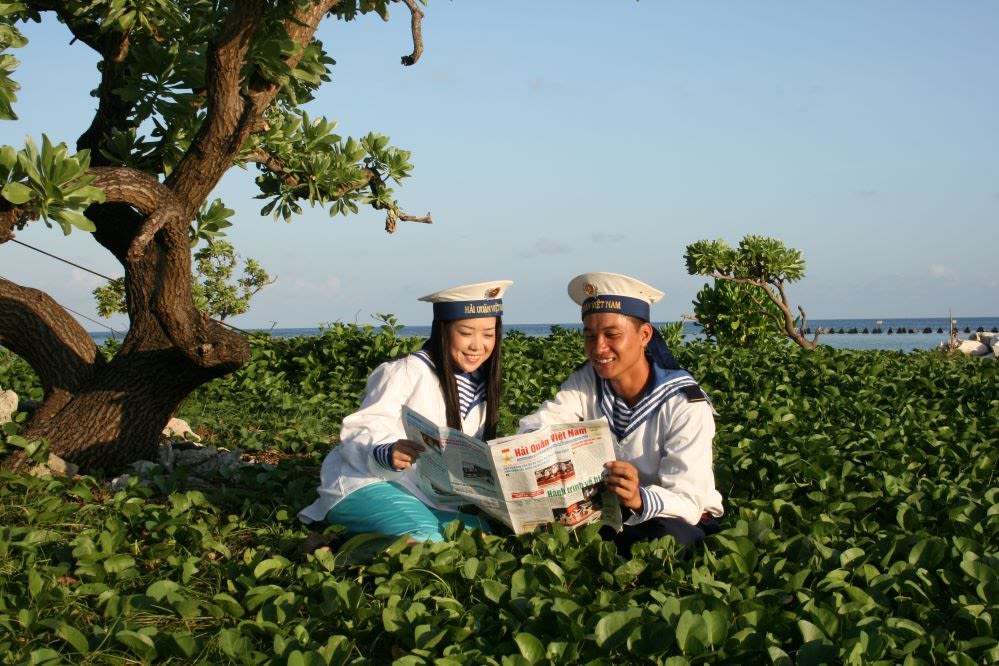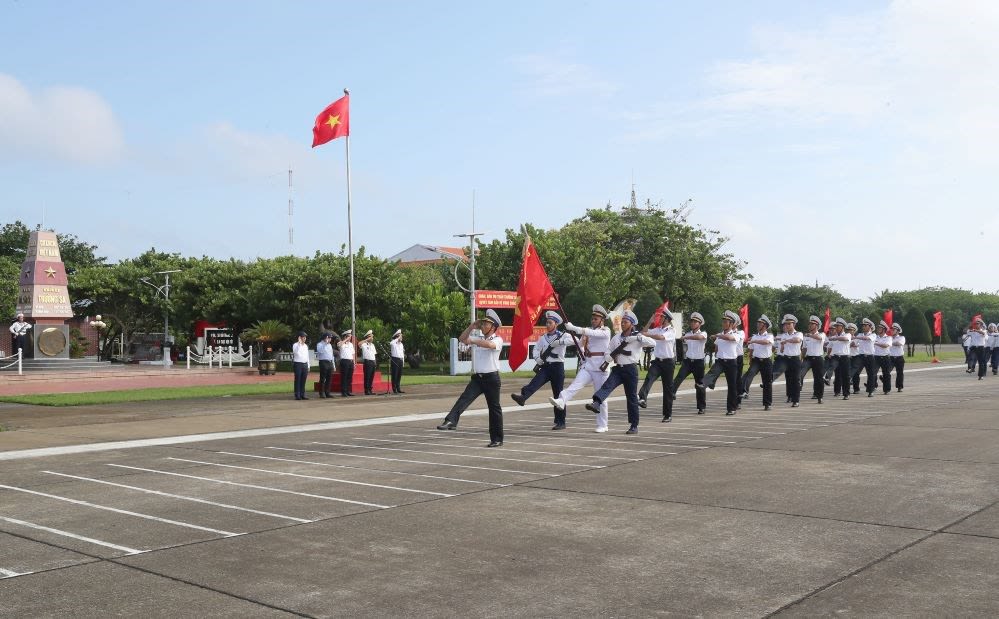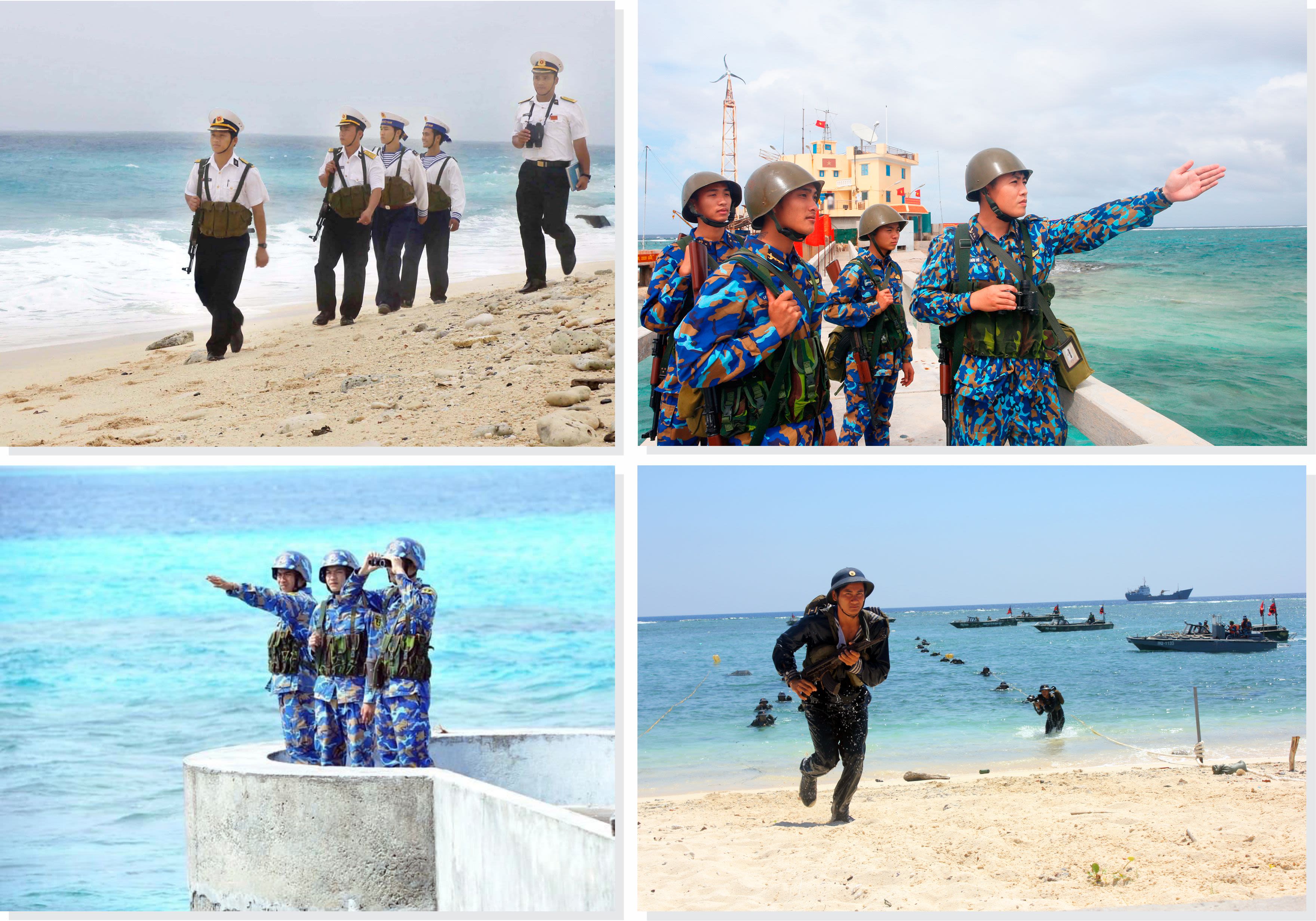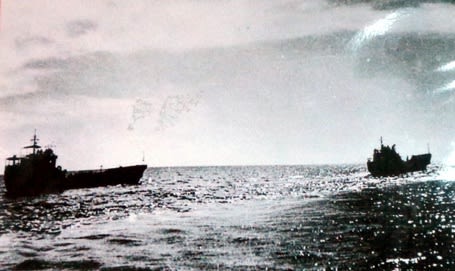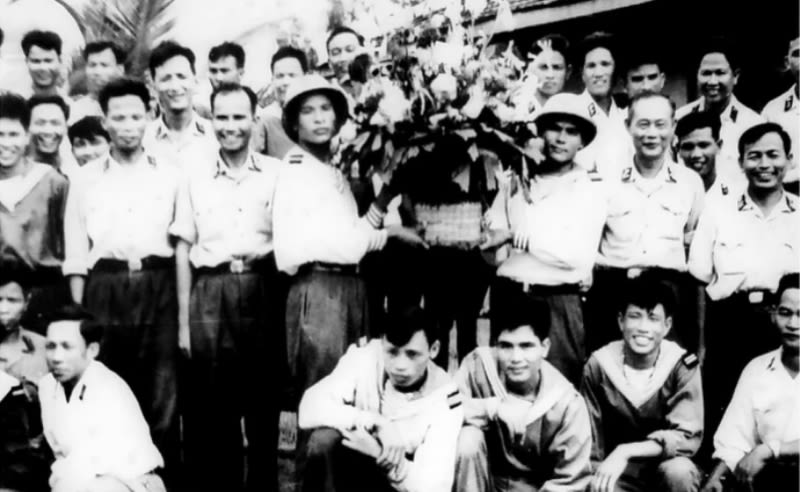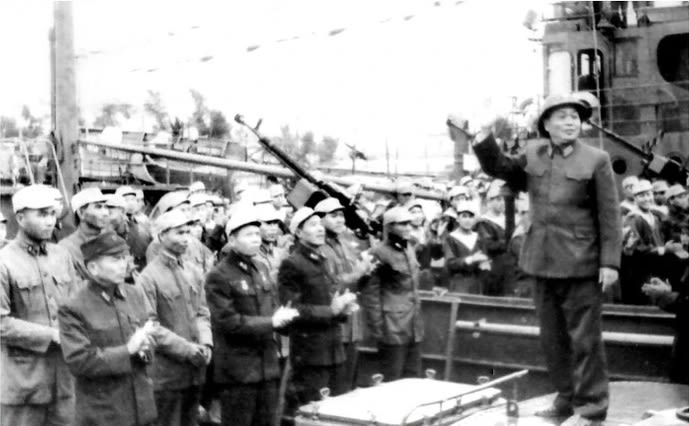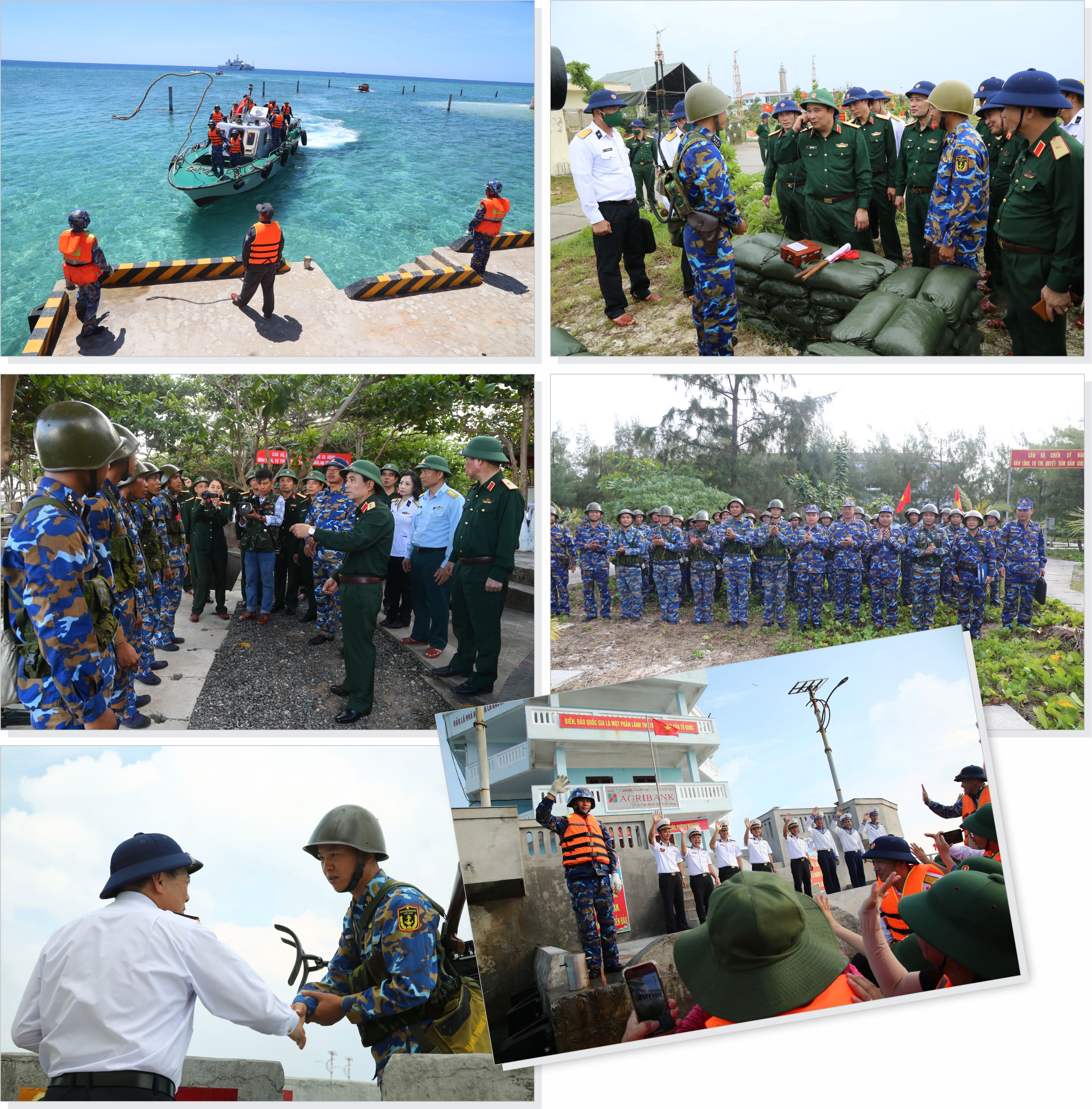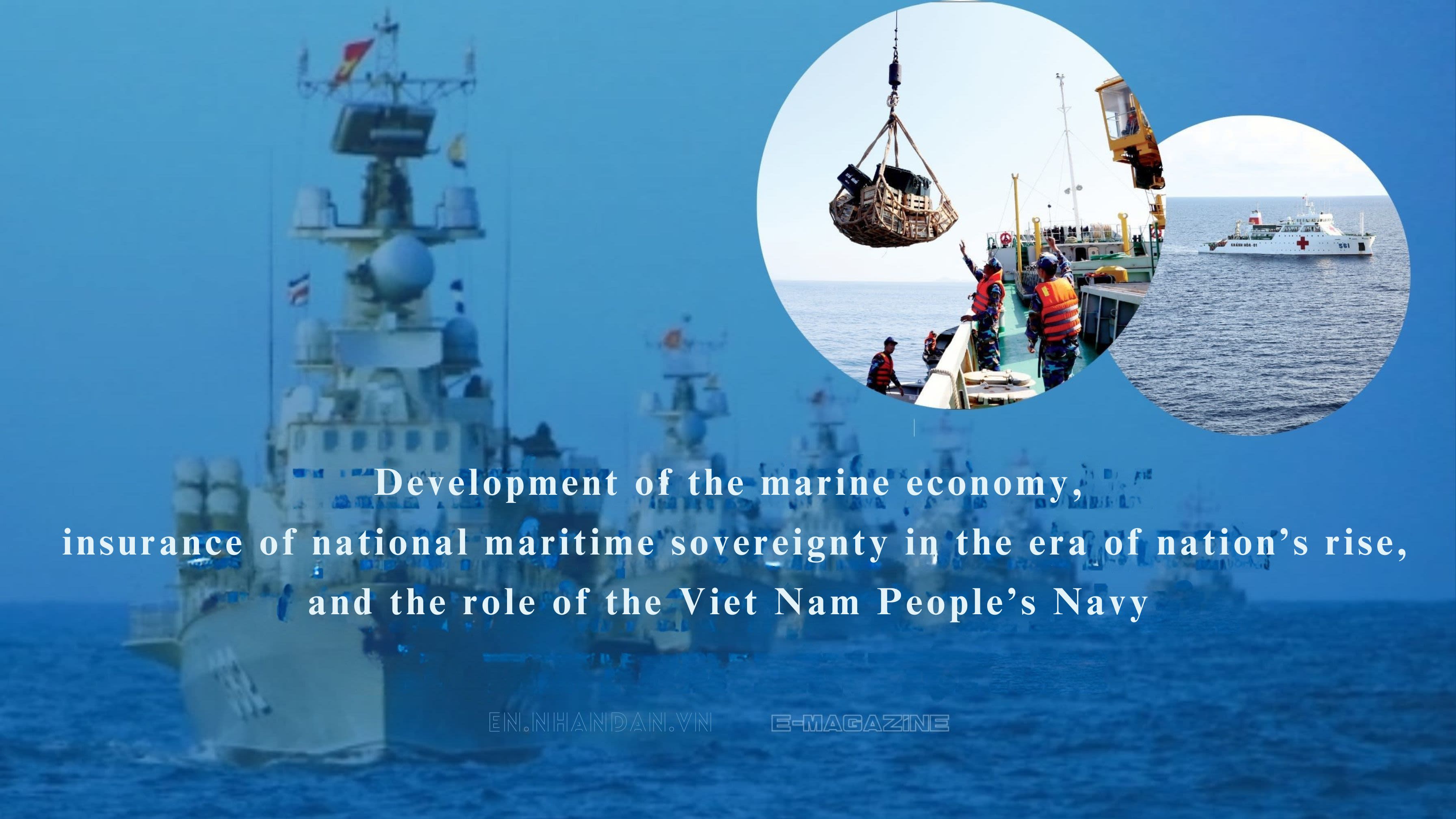
Vice Admiral Tran Thanh Nghiem, Member of the Party Central Committee,
Commander of the Viet Nam People’s Navy.
The integrated development of the marine economy and the protection of national maritime sovereignty is a consistent strategic policy of our Party. It is the responsibility of the entire political system, including the Viet Nam People’s Navy. In the era of nation’s rise, the Viet Nam People’s Navy, together with other forces across the military, must continue to effectively perform its functions as “a fighting force, a working force, and a labour production force”; serve as the core in firmly protecting sovereignty and maintaining a peaceful and stable maritime environment; and actively participate in economic development and sea-based defence activities in sectors and industries with potential and strengths, such that the country can develop in a rapid and sustainable manner.
Developing marine economy
in association with ensuring national maritime sovereignty
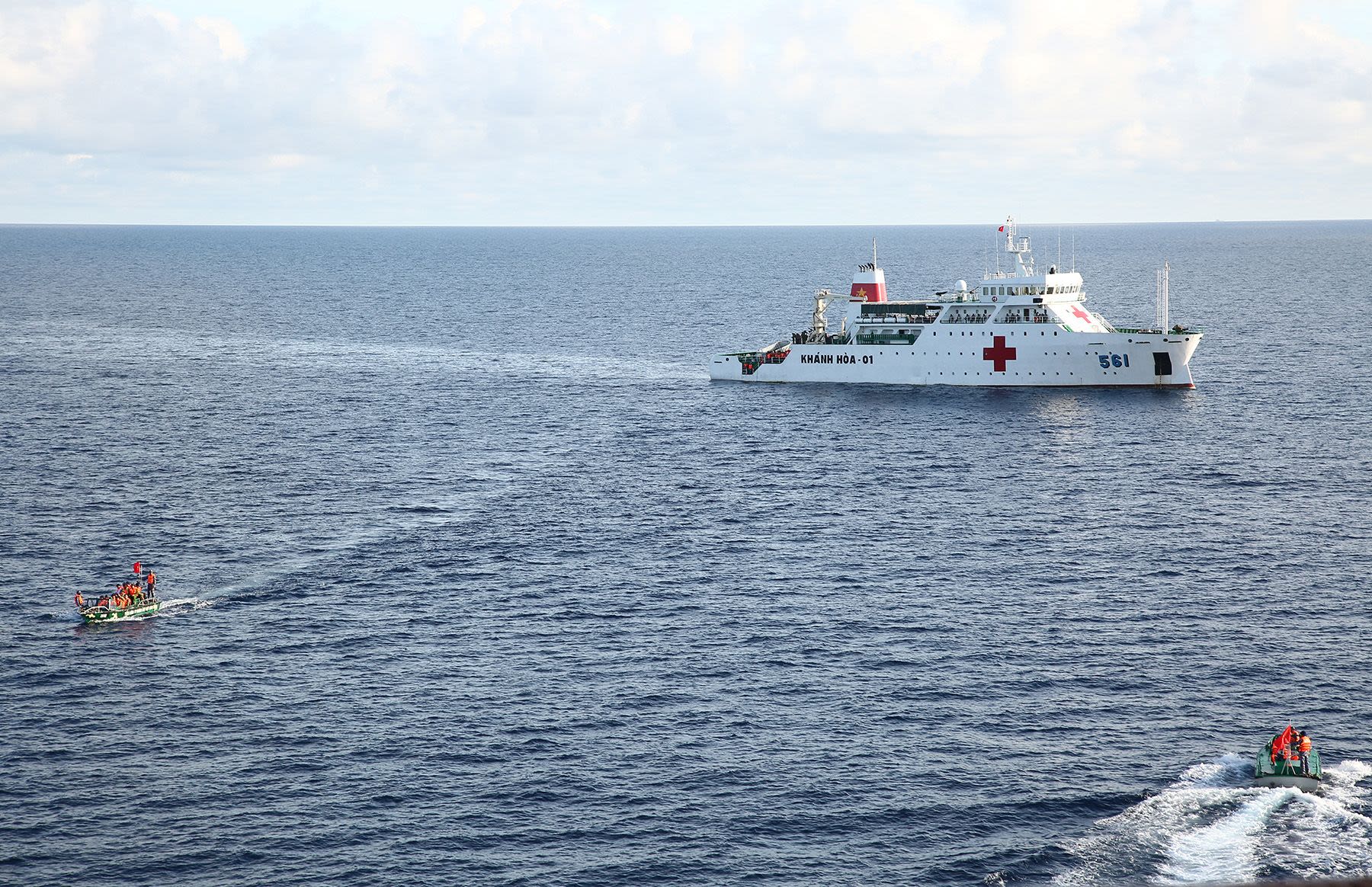
Viet Nam is a maritime nation, with a sea area of about 1 million sq.km, three times larger than its land area, along with thousands of large and small islands and a coastline stretching more than 3,260 km. Viet Nam’s seas and islands constitute an integral part of national sovereignty; they are living space and gateways for international exchange; hold strategic positions in economy, defence, and security; and are closely linked to the cause of national construction and protection.
Our seas and islands are rich in resources, creating favourable conditions and great potential for developing marine economic sectors that bring high value such as maritime transport, tourism, oil and gas, mining, aquaculture and seafood exploitation, and renewable energy. Our sea areas, especially the two offshore archipelagos of Hoang Sa (Paracel) and Truong Sa (Spratly), are likened to “natural fortresses”, enhancing defence depth and providing the necessary space to control access to the mainland territory.
Managing and exploiting the sea’s potential goes hand in hand with firmly protecting national maritime sovereignty, making the country prosperous and strong. This is the fundamental viewpoint and consistent strategic policy of our Party.
The Party and state have issued many directives, resolutions, and legal normative documents to complete the institutional framework, establish political foundations and legal corridors to promote marine economic development linked with ensuring maritime defence and security.
Notably, Resolution 36-NQ/TW (dated October 22, 2018) on “The strategy for sustainable development of Viet Nam’s marine economy to 2030, with a vision to 2045” sets forth the viewpoint that: “Viet Nam must become a strong maritime nation, wealthy from the sea, sustainably developed, prosperous, secure, and safe; develop a sustainable marine economy linked with ensuring defence and security, firmly maintaining independence, sovereignty, and territorial integrity; strengthen diplomacy and international cooperation on maritime issues; and contribute to maintaining a peaceful and stable environment for development.”
Resolution 36 outlines specific goals and solutions for marine economic development and national sovereignty protection.
Regarding the marine economy, by 2030, pure marine economic sectors are expected to contribute about 10% of GDP; the economies of 28 coastal provinces and cities will account for around 65-70% of GDP; marine economic development will follow international sustainability standards; and resource exploitation will be controlled within the recovery capacity of marine ecosystems.
Regarding defence and security, the resolution defines building a revolutionary, regular, elite armed force oriented toward modernisation, prioritising the modernisation of certain military branches and law enforcement forces at sea; continuously consolidating and strengthening the all-people defence and people's war strategy; ensuring the capacity to effectively handle maritime situations and firmly maintain independence, sovereignty, sovereign rights, jurisdiction, and national interests in maritime zones.
Following the Party and state’s policies, the integrated development of the marine economy and the protection of national maritime sovereignty has achieved many important results. Awareness and responsibility of Party committees, authorities, cadres, Party members, and people regarding the importance of seas and islands, marine economic development and maritime sovereignty protection have gradually increased.
Marine economic sectors have rapidly developed, contributing significantly to the national economy and becoming a key driving force for national development. The economic and social infrastructure system and living standards of people in coastal and island areas have continuously improved. Scientific research and fundamental investigations into marine resources and environment, the training and development of human resources in the maritime sector, have been given due attention.
These efforts have contributed to creating stable jobs, promoting the restructuring of industries towards industrialisation, modernity, and sustainability. The integrated development of the marine economy and the protection of national maritime sovereigntyy is increasingly tight and synchronous, from strategic planning to investment, construction, production, and business development. Forces responsible for managing and safeguarding sovereignty and enforcing the law at sea, such as the Navy, Coast Guard, Border Guard, and Fisheries Surveillance, have received substantial investment, resulting in enhanced overall capabilities and combat strength.
The all-people defence posture, people’s security posture, and the “posture of people’s hearts and minds” at sea have been consolidated and reinforced to meet the demands of new tasks in the current context.
Developing the marine economy in conjunction with ensuring national maritime sovereignty is a consistent strategic policy of our Party and the responsibility of the entire political system, including the Viet Nam People's Navy.
However, there remain limitations, challenges, and difficulties in developing the marine economy and ensuring national maritime sovereignty. The international, regional, and East Sea/South China Sea situation continues to develop in a complex and unpredictable manner. Strategic competition among major powers and fierce territorial and maritime sovereignty disputes carry potential risks of conflict and instability.
Domestically, there is still a lack of unified awareness and coordinated action among some groups of people regarding the sea and island-related issues. Hostile forces continue to exploit the complexity and sensitivity of the sea and island issues to carry out sabotage activities. Development efforts have yet to fully tap the potential and advantages of the sea and islands. Viet Nam has not yet become a strong maritime nation or rich from the sea.
The planning and implementation of strategies and master plans in some periods and fields have not closely linked economic development with national defence and security, thus failing to effectively combine and optimise investment resources or promote the complementary strengths of sectors and marine economic zones. In some areas, development investment remains fragmented, inconsistent, and inefficient, lacking interconnectivity across ministries, sectors, and regions. Investment attraction into high-tech marine industries remains limited, and economic restructuring has been slow. The maritime management and protection forces still lack adequate equipment and resources, making it difficult to maintain a continuous presence across the vast maritime area. Coordination mechanisms, direction, and operational management among the forces remain inconsistent and in need of improvement
As the country enters a new era of national rise, the task of sustainably developing the marine economy while firmly safeguarding national maritime sovereignty faces opportunities and challenges. This is one of the key strategic missions, contributing to the realisation of Viet Nam’s vision for a new era with its two centennial goals: by 2030, marking the 100th anniversary of the founding of the Communist Party of Viet Nam, the country aims to become a developing nation with modern industry and upper-middle income; and by 2045, celebrating the 100th anniversary of the National Day, Viet Nam aims to become a developed socialist country with high-income.
Flag-raising ceremony on Truong Sa Archipelago.
Flag-raising ceremony on Truong Sa Archipelago.
The entire Party, people, and armed forces must continue to effectively address the relationship between economic development and the consolidation and enhancement of national defence and security; between the exploitation of maritime potential and strengths and the firm protection of national sovereignty; between the construction of marine development capacity and the strengthening of maritime defence capabilities. The robust marine economic development will provide momentum and favourable material conditions to enhance national defence and security and ensure firm, unified, and comprehensive protection of maritime and island sovereignty.
At the same time, the firm securement of national defence and security is a prerequisite for protecting maritime and island sovereignty and for maintaining peace and stability, thus creating a safe and favourable environment and space for sustainable and effective development of marine economic sectors.
To accelerate the marine economic development while safeguarding national maritime sovereignty, it is necessary to thoroughly grasp, concretise, and implement the “Strategy for Protecting the Fatherland in the New Situation” and the “Strategy for the Sustainable Development of Viet Nam's Marine Economy by 2030, with a Vision to 2045”. Attention must be paid to information dissemination and awareness-raising of the position and role of the sea and islands, sustainable marine economic development, and its connection to national defence and security and national maritime sovereignty in the new context. It is also essential to build and complete mechanisms, policies, strategies, and comprehensive plans that combine economic development with national defence and security in coastal and marine areas.
Efforts are being made to attract resources to develop foundational and spearhead economic sectors as well as to establish modern economic zones, industrial parks and coastal urban areas. Development is being pursued on the basis of a green marine economy and the “circular economy”, closely linked to the conservation of marine ecosystems and the protection of natural resources and the environment. Scientific and technological research, application and development are being promoted alongside the training of high-quality human resources in maritime fields; as well as the fundamental study and investigation of marine resources, disaster forecasting and warning, environmental monitoring and surveillance, disaster prevention and recovery, search and rescue, and adaptation to climate change and sea level rise.
Continued attention is being given to investing in the building of a strong all-people national defence posture at sea, with the Viet Nam People's Navy serving as the core force. The construction of modern, synchronised infrastructure is being accelerated on islands and at sea, ensuring both national defence and security missions and the development of the economy and society, thereby improving people’s livelihoods. These efforts contribute to strengthening the people’s defence posture, enhancing overall strength to firmly safeguard national sovereignty over seas and islands, and to ensure the sustainable development of the marine economy in the new era.
The role of the
Viet Nam People's Navy

The Viet Nam People's Navy was established on May 7, 1955. Over 70 years of building, combat and development, the naval service has recorded numerous outstanding military feats, notably including: winning its first battles on August 2 and 5, 1964; joining forces with the people of North Viet Nam to twice defeat the US imperialists in their destructive war; taking the lead in fighting against the US imperialists' blockade of the northern rivers and seas; opening the Ho Chi Minh Trail at sea to transport supplies to the south; forming and deploying special naval commando units in Cua Viet and Dong Ha; participating in the General Offensive and Uprising in the Spring of 1975 to liberate the south and the Truong Sa (Spratly) Archipelago; fulfilling international missions in Laos and Cambodia; and building a “revolutionary, regular, elite, and modern” naval service. The Navy has been the core force in firmly protecting sovereignty over seas and islands, while maintaining peace and stability at sea to facilitate national development.
Alongside fulfilling military and defence duties, the naval service has always actively participated in production and economic development. This has served as a vital lesson enabling its continuous growth and maturity, successfully fulfilling the dual role of “a combat force, a working force, and a production force.”
Specifically, as the core force in defending maritime sovereignty, naval troops regularly operate at sea, possess extensive maritime knowledge, are equipped with specialised technology and equipment, and are adept at harnessing potential and strengths to implement the strategy of combining economic development with defence, integrating marine economic development with the safeguarding of national sovereignty over the seas.
Naval troops stationed in Truong Sa strictly maintain training routines and combat readiness.
Naval troops stationed in Truong Sa strictly maintain training routines and combat readiness.
Even during wartime, naval troops upheld the spirit of self-reliance, building while fighting, engaging in production and cultivation to improve their living conditions, repairing weapons and equipment, and supplementing their resources. Following national reunification and peace, the Navy gained favourable conditions to more effectively contribute to the development of the maritime economy and defence.
In line with the Party and state’s policies on combining economic development with defence, as early as 1976, the Standing Committee of the Naval Party Committee issued Resolution 431/DU on participating in production and economic development. The resolution stated that “The Navy’s main direction in participating in production and economic development is towards the sea, with a focus on developing fisheries and exploiting marine resources; with the exploration and extraction of oil and gas and maritime transport as important priorities; while also enhancing the industrial capacity of its enterprises, actively engaging in infrastructure development, and making full use of conditions and available capabilities to boost production and animal husbandry.”
Simultaneously, based on the economic development tasks assigned by the government to the armed forces, the Naval Service established the Department of Economic Development to advise, direct, and implement marine economic development efforts. The establishment of this department marked a new phase in the development of the Navy’s organisational structure, concretising the Party’s comprehensive reform agenda, beginning with the transformation in economic thinking initiated and led by the Party.
Since it was assigned economic development duties by the government and the armed forces in 1976, the Naval Service has always viewed participation in labour and production as one of its core political tasks, inseparable from its military and defence responsibilities. The Naval Service regularly thoroughly grasps and rigorously implements the Party’s guidelines and policies and the State’s laws.
It has directed defence-related enterprises and economic units to harness internal resources, overcome challenges, foster innovation, and tap into all available resources, potential and advantages to conduct quality and effective production and business operations, closely linked with military and national defence duties, the protection of the country’s sea and island sovereignty and resources. Efforts have been made to actively develop several efficient, pioneering, dual-purpose production and economic models associated with building an all-people defence posture at sea and on islands.
A vessel of Unit 125 transporting special forces to liberate the Truong Sa (Spratly) Islands.
A vessel of Unit 125 transporting special forces to liberate the Truong Sa (Spratly) Islands.
Officers and soldiers of Unit 125 receiving a floral basket from President Ton Duc Thang in Spring 1969.
Officers and soldiers of Unit 125 receiving a floral basket from President Ton Duc Thang in Spring 1969.
General Vo Nguyen Giap visiting and addressing officers and soldiers of Unit 125 in 1970.
General Vo Nguyen Giap visiting and addressing officers and soldiers of Unit 125 in 1970.
The Naval Service has established several strong defence-economic enterprises and units operating in key sectors such as: seaport exploitation and logistics services; shipbuilding and ship repair; protection service for oil and gas exploration and exploitation; construction and maintenance of marine and offshore facilities; fishing and aquaculture; provision of fishery logistics services; and marine and island tourism.
These industries have generated substantial revenue, contributing to the national economy while also providing resources to improve soldiers’ livelihoods and support the investment in equipment and vehicles for military and defence tasks. A prime example is Saigon Newport Corporation – Viet Nam’s largest seaport and logistics service provider, ranked among the world’s top 16 container port clusters by throughput, and one of the country’s leading maritime economic brands. Alongside are shipbuilding and repair plants, and defence-economic flotillas operating public-benefit fishing fleets, service vessels, and fisheries logistics and technical service centres.
To support the development of marine and island infrastructure, the Naval Service has advised the Central Military Commission and the Ministry of National Defence on the implementation of major projects and strategic, dual-use facilities such as ports, airstrips, harbours, fishing villages, marine and island defence-economic zones, and defensive structures.
These initiatives have played a key role in boosting socio-economic development while strengthening defence capabilities at sea. Concurrently, naval units, in the course of fulfilling their maritime missions, regularly provide support and ensure the safety of maritime economic activities; they are actively involved in search and rescue operations, particularly in remote sea areas, guided by the spirit that “helping the people is a peacetime combat mission, a command from the heart.” They also supply fuel, freshwater, food, and provisions to fishing vessels, enabling fishermen to venture further offshore and maintain a constant presence at sea, especially in distant waters.
Delegations visiting, inspecting, and encouraging troops and residents of Truong Sa to remain steadfast in safeguarding the nation's sea and islands sovereignty.
Delegations visiting, inspecting, and encouraging troops and residents of Truong Sa to remain steadfast in safeguarding the nation's sea and islands sovereignty.
Viet Nam is now entering a new era – an era of national resurgence. To contribute to the shared efforts of the entire Party, people and armed forces in successfully carrying out the cause of developing the marine economy and protecting national maritime sovereignty, the Viet Nam People's Navy must continue to effectively fulfil its functions and duties as a “fighting force, a working force, and a production force” under new conditions and in new circumstances.
In performing its function and role as a “fighting force”, amid increasingly complex and unpredictable developments in the global, regional and East Sea (South China Sea) context, and growing demands in defending the nation’s sea and islands sovereignty, the Naval Service continues to thoroughly grasp and strictly implement the Party’s guidelines and policies and the State’s laws, particularly Resolution No. 8 of the 13th Party Central Committee on the “Strategy for Safeguarding the Fatherland in the New Situation” and Resolution No. 36-NQ/TW on the “Strategy for Sustainable Development of Viet Nam's Marine Economy to 2030, with a Vision to 2045”.
It also regularly raises vigilance, conducts in-depth analysis and accurate forecast of developments; proactively advises the Central Military Commission and the Ministry of National Defence on fundamental, strategic, long-term sea and islands policies and solutions, ensuring timely and appropriate responses to any situation. These efforts aim to firmly protect sovereignty over seas and islands, marine economic activities, national rights and interests, and to maintain a peaceful and stable environment at sea for the country to develop and prosper in the new era.
The Navy will continue researching, providing consultation and proposing to the Central Military Commission and the Ministry of National Defence for the development of a strong, in-depth, and interconnected all-people national defence posture at sea, linking land, sea and islands, with the Navy playing a core role. The Navy must be truly “lean, compact and strong,” and “revolutionary, standardised, skilled and modern,” with an ever-increasing level of combat readiness.
In fulfilling its function and role as a “working army,” the Navy must place emphasis on effective mass mobilisation work in the new context, particularly in strategically vital areas such as borders, seas and islands.
The key priority is close and regular coordination with relevant committees, ministries, sectors, units and localities to intensify communication efforts concerning maritime and island issues, raising awareness and responsibility among all levels, sectors, officials, Party members and the people regarding the position, role and significance of Viet Nam’s seas and islands in the cause of national construction and defence; as well as the Party’s and State’s viewpoints, stances, guidelines, policies and laws on sustainable marine economic development in conjunction with the defence of national maritime sovereignty.
Communication on maritime and island matters must be linked with campaigns to mobilise resources for building a modernised Navy. Determined efforts are needed to counter the plots and tactics of hostile forces who exploit complex and sensitive maritime issues to undermine the Party and State.
The effective implementation of programmes such as “The Viet Nam People’s Navy as a Pillar for Fishermen Venturing Offshore” and activities such as “The Navy Sponsoring Fishermen’s Children” must be maintained. The Navy must also support communities in disaster prevention and response, as well as in search and rescue operations, thereby contributing to building a “people’s defence posture at sea” and consolidating the comprehensive strength required to firmly safeguard maritime sovereignty and ensure sustainable marine economic development.
Simultaneously, the Navy must thoroughly grasp and effectively implement the Party’s and State’s foreign policy and international integration strategy; promote substantive and in-depth defence diplomacy with the armed forces and navies of other countries, on both multilateral and bilateral levels, especially with the navies of ASEAN countries, major powers, and traditional friends and partners; work with countries’ navies to strengthen mutual understanding and trust, build peaceful, stable maritime zones; enhance the status and reputation of the Viet Nam People’s Navy, create a favourable international environment for the early and long-range defence of national maritime sovereignty.
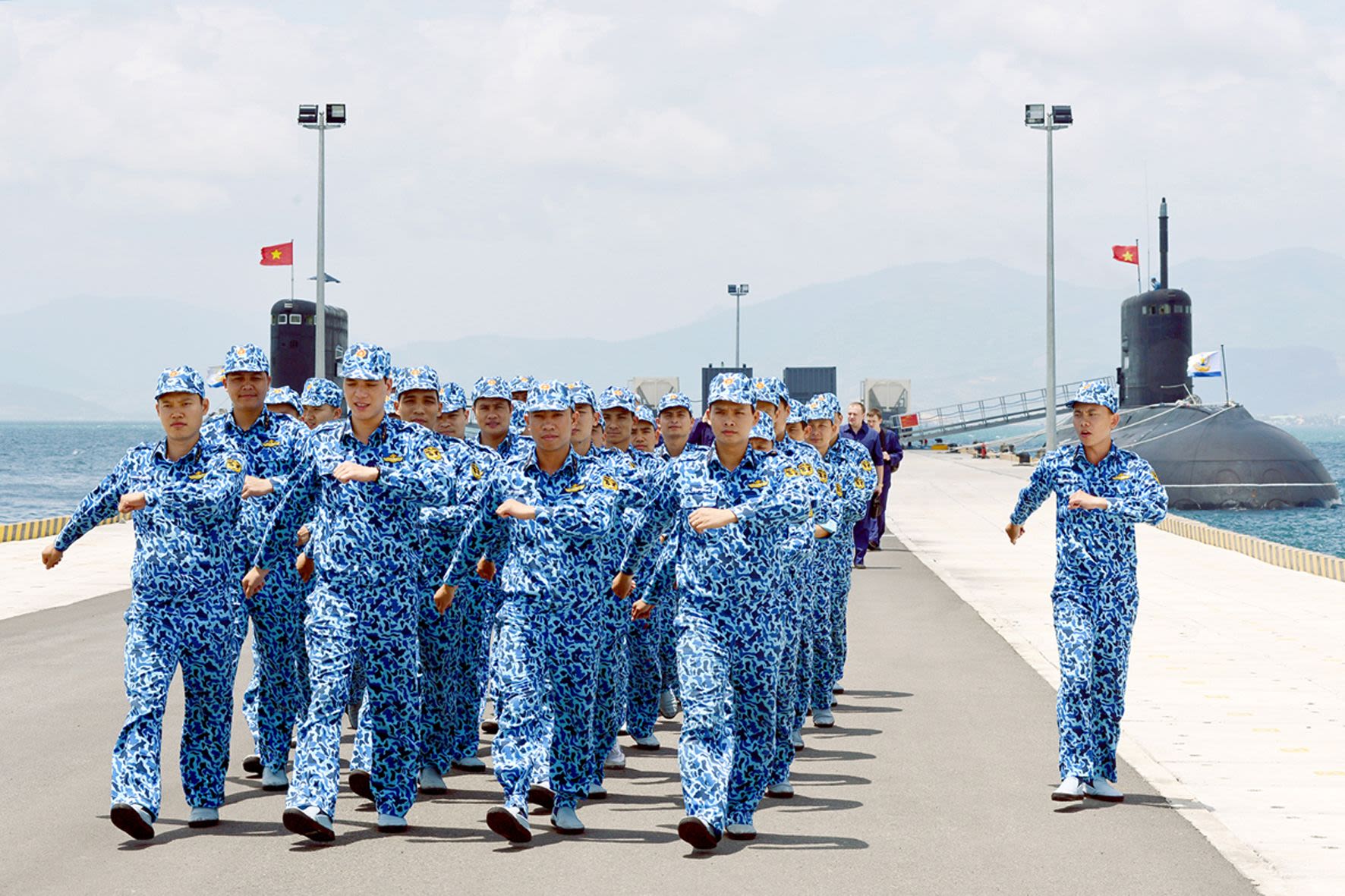
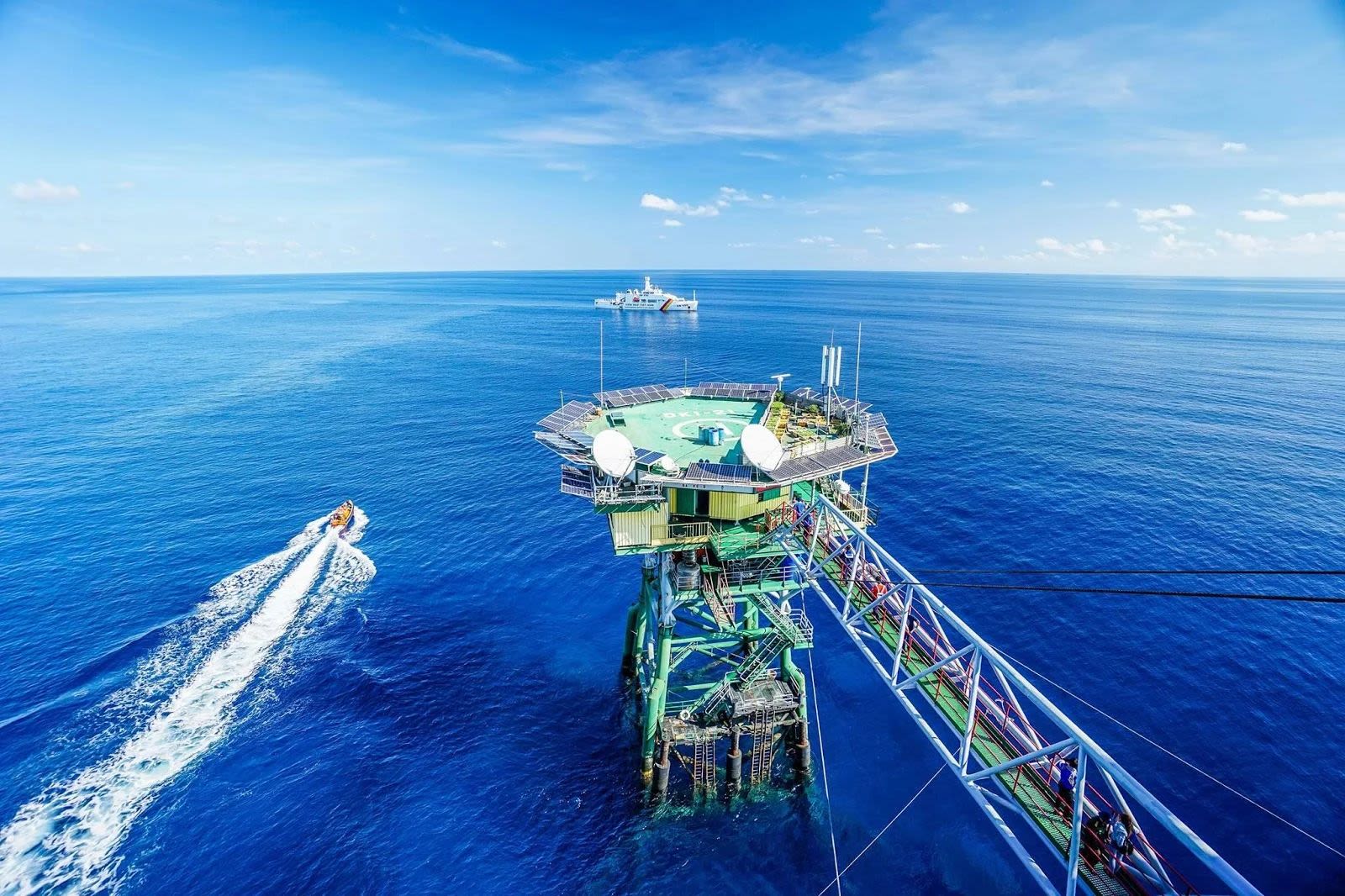
In carrying out its function and role as a “production army,” the Navy must fully grasp and implement the Party’s, State’s, Central Military Commission’s, and Ministry of National Defence’s guidelines, policies and laws on combining economic development with national defence.
It is necessary to continue restructuring, reorganising and innovating the operations of naval enterprises to improve production and business efficiency, as well as capacity to perform defence and military tasks.
Efforts must be made to build a strong contingent of naval entrepreneurs; utilise high-quality human resources; and streamline enterprise organisational structures to ensure they are compact, efficient and effective. The Navy should maximise its strengths in various sectors, including shipbuilding and repair, port operations, logistics services, and the protection of maritime oil and gas activities.
It is essential to organise effective fisheries logistics services to provide a firm support base for fishermen working offshore. Greater effort must be made to implement projects that develop dual-use infrastructure in maritime and island areas.
Naval enterprises must actively engage in scientific research, adopt advanced technologies, embrace digital management, develop digital infrastructure, and make effective use of digital resources; train and recruit highly skilled personnel; prevent waste, unlock potential and resources; and expand production and business scale.
A key initiative is the implementation of the plan to transform Saigon Newport Corporation into a Marine Economic Corps, based on three traditional pillars (port operations, logistics services, and maritime transport and economic sectors) and two newly added pillars (industrial park investment and business; marine and island tourism services and offshore renewable energy development); create an integrated ecosystem connecting production and logistics, optimising costs and making a crucial contribution to enhancing the competitiveness of Vietnamese goods in international markets, supporting the country’s goal of achieving 8% economic growth by 2025 and reaching double-digit growth in the era of national rise.
The integrated development of the marine economy and the protection of national maritime sovereignty is a critically strategic mission for the entire Party, people, and armed forces. In the time ahead, the Viet Nam People’s Navy will continue building a force that is “lean, compact and strong,” “revolutionary, standardised, skilled and modern,” with ever-greater overall quality and combat strength, truly serving as the core in firmly safeguarding national maritime sovereignty, while actively contributing to the development of the marine defence economy, helping the country confidently stride forward into a new era of wealth and prosperity.
Design: NDO
Photos: NDO, Viet Nam Navy Newspaper, VNA


